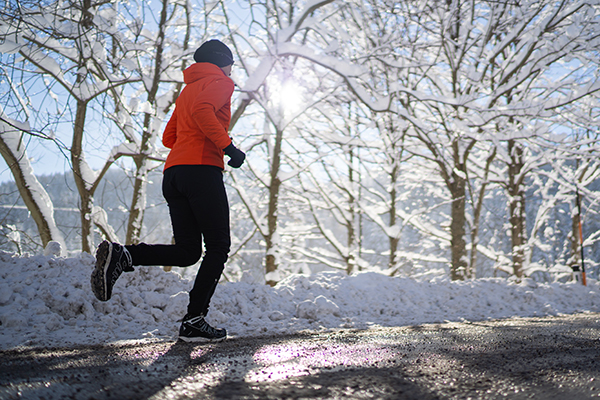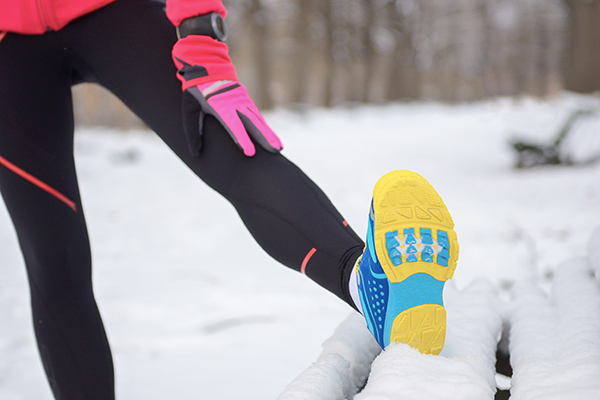7 Tips for Running in Cold Weather

When temps drop, many runners sprint to the treadmill.
While there’s nothing wrong with taking your workouts indoors (30 Day Breakaway offers fun treadmill routines to keep you fit), learning how to handle the cold can keep your runs fresh during the long winter ahead.
The key to successful cold-weather running is to come prepared.
With the right approach, you’ll be able to handle the cold like a champ, and even enjoy your outdoor runs.
Here are 7 tips for running in cold weather.
1. Use the Wind to Your Advantage

You probably won’t be able to escape cold winds for your entire run, but you can plan your route so the wind works in your favor as much as possible.
“For winter running, it’s often best to go out against the wind, especially if the day has a colder wind chill,” says Kelly Mortenson, a USA Track and Field-certified running coach in Minnesota.
This way, you’ll have the wind to help you on the way back when you’re already warm and sweating from the effort.
“If you do it the opposite way, you can freeze trying to run against the cold wind after sweating on the way out,” Mortenson explains.
2. Layer Up
Dressing in layers is key for staying warm when temps drop.
Look at the “feels like” temperature to see if there’s any wind and use that lower temp to help you figure out what to wear, advises Idalis Velazquez, Super Trainer and creator of 30 Day Breakaway.
Start with a base layer made of moisture-wicking fabric like polyester (or a polyester blend), wool, or bamboo.
“Depending on winter temperatures in your area, you may need to invest in both a medium-weight and a heavy-weight base layer shirt,” Velazquez notes.
“The one fabric you should shy away from is cotton,” Mortenson says. “Though it’s a great fabric, it’s not the best at wicking away sweat, and once it gets wet, it tends to stay wet.”
As temperatures dip, you may want to add another moisture-wicking layer. Then, top everything with a wind-proof outer layer, a hat (or headband), and gloves.
Depending on the temps and weather conditions, you may also want a neck gaiter or face mask. When possible, look for reflective running gear.
“With limited daylight, chances are you’ll be running in the dark, and snowbanks on plowed streets can make you even harder to see,” Velazquez warns.
3. Splurge on Shoes

If you live in a snowy, windy area, chances are your usual go-to running shoes won’t be enough to keep your feet warm and dry.
So, save your regular running shoes for the treadmill and splurge on specialty footwear.
Mortenson recommends running shoes made with Gore-Tex technology, which features a waterproof membrane that keeps out snow, wind, and other elements.
Trail shoes may also work, as they have rugged soles that can help you in the snow. If it’s really icy, you may need traction cleats like Yaktrax to add grip to your shoes, Mortenson says.
Don’t forget the moisture-wicking, cold-weather socks!
4. Run Indoors When Needed
Sometimes it’s just too cold, snowy, and slippery to run outside.
“If the weather conditions don’t allow for good traction, or compromise your ability to control your breathing, I recommend heading indoors for a treadmill session,” says Beachbody fitness expert Cody Braun.
Velazquez agrees: “Cold temperatures and dry air can aggravate some health conditions, so use your best judgment as to whether you should run outside or hit the treadmill instead.”
Similarly, if you simply can’t keep your muscles warm during an outdoor run, it might be wise to cut your workout short and do one of the 30 Day Breakaway treadmill sessions instead.
All treadmill workouts include a video option to make your run more interactive!
5. Drink Up
It’s important to stay hydrated before and during exercise — no matter what the thermometer reads.
The total amount of water you need per day is highly individual, so Beachbody recommends using body weight as a general guide.
Simply divide your body weight (in ounces) by two, and aim to drink that amount in water every day. So if you weigh 150 pounds, you should down at least 75 ounces of water per day.
6. Let Your Heart Rate Guide You

It can be tough to hold your usual pace while navigating snowy, icy roads. So, instead of trying to nail a specific pace, Mortenson recommends going by heart rate or perceived effort.
“If you strive to keep perceived effort or heart rate range the same, you’ll be working in the right zone for that given day,” he says.
7. Watch Out for Signs of Frostbite and Hypothermia
As temps drop and the wind picks up, your risk of serious health issues like frostbite and hypothermia goes up. For your own health and safety, it’s important to know the warning signs of both.
Frostbite signs and symptoms include numbness, loss of feeling, or a stinging sensation on exposed skin, hands, and/or feet. If you recognize any signs of frostbite, get inside ASAP and slowly warm — but don’t rub — the affected area.
Seek emergency help if the numbness doesn’t go away. Hypothermia signs to watch out for include:
- Shivering
- Slurred speech
- Loss of coordination
- Drowsiness
- Memory loss
Get emergency help if you suspect hypothermia.
